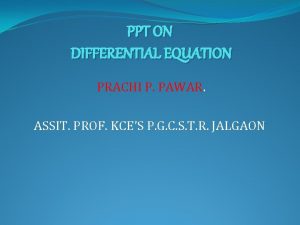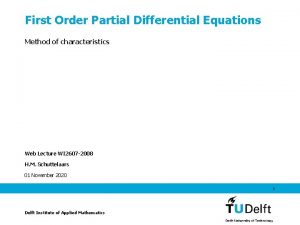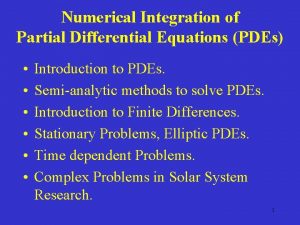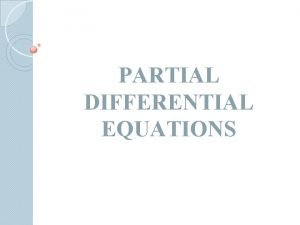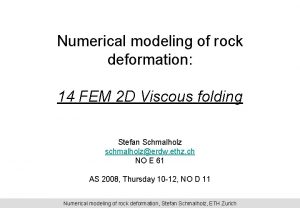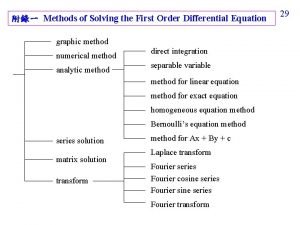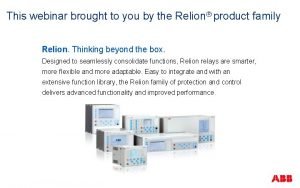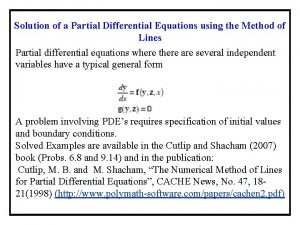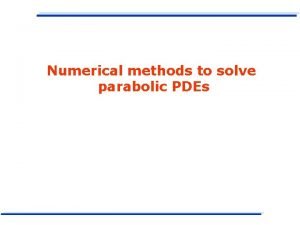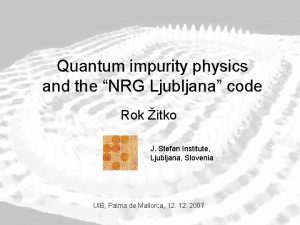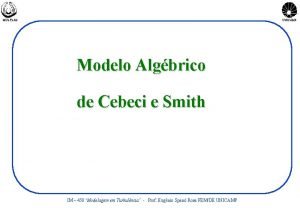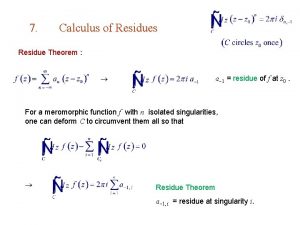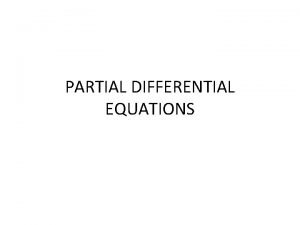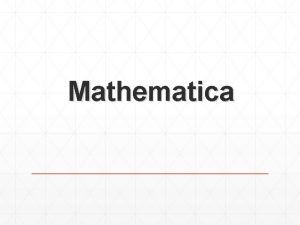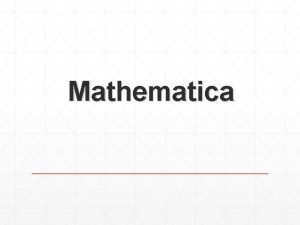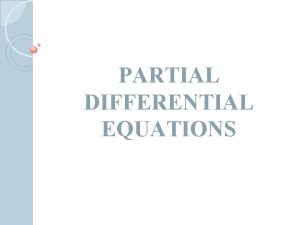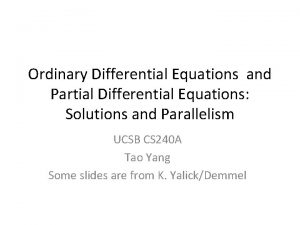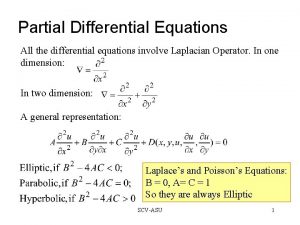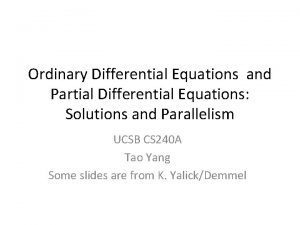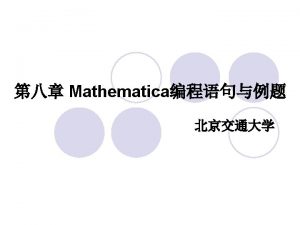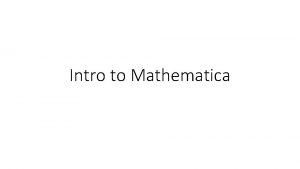Teaching Partial Differential Equations Using Mathematica Katarina Jegdic
















- Slides: 16

Teaching Partial Differential Equations Using Mathematica Katarina Jegdic Assistant Professor Computer and Mathematical Sciences Department University of Houston – Downtown Wolfram Technology Conference, Champaign October 21, 2011

Introduction Ø Traditional way of teaching upper level mathematics courses l l l Ø Proposal at UHD for the Quality Enhancement Plan (QEP) grant l l l Ø One way communication Instructor lecturing Students watching, listening, taking notes and working individually on assignments Students taking a more active role in the course Students working in small teams on solving research problems Active learning and cooperative learning, learning by teaching others, discussing, using technology, presenting results Math 4304 (Introduction to Partial Differential Equations) at UHD l l Differential equations play a prominent role in physics, chemistry, engineering, biology, economics, etc. Applications in fluid dynamics, oil industry, medicine, aerospace engineering, traffic control, etc. (Houston oil sector, Texas Medical Center, NASA)

Course Implementation Ø Math 4304 syllabus: l Heat equation in one-dimension • Derivation, boundary conditions, derivation in 2 d and 3 d l Method of separation of variables • Introduction, linearity, examples with the heat equation l Laplace equation • Equation inside a rectangle, equation for a circular disk l Fourier series • Introduction, convergence theorem, Fourier Cosine and Sine series, term-byterm differentiation and integration l Wave equation • Introduction, derivation, boundary conditions l Sturm-Liouville eigenvalue problems • Introduction, examples, general classification, self-adjoint operators, Rayleigh quotient l l l Nonhomogenous problems Fourier Transform solutions of PDEs Laplace Transform solutions of PDEs

Course Implementation - continued Ø Real world problems motivate students and give meaning to the material studied in class l l Ø Often too complex for explicit solving Need to develop numerical methods Projects consist of l Derivation of differential equations which describe particular physical phenomenon • The equations are simplified enough so that their basic properties could be understood analyzed theoretically l Study of numerical methods for the approximate solving • Students derive numerical methods based on the equation (finite difference, finite volume) l Implementation of codes using Mathematica, Matlab or Maple

Course Implementation - continued Ø Applications Aerodynamics Shallow Water Equations Oil Flow Heat Equation Traffic Flow Wave Equation

Time table Ø First week l l The instructor provides a detailed study guide for each project consisting of book chapters, research articles, codes and any additional information Projects consist of: • • • Ø Derivation of the equations Development of numerical methods for approximate solving Codes in Mathematica/Matlab/Maple Remaining three weeks l l Problem driven, student-oriented Students work in teams • Understand particular example, derive equations, derive numerical methods • Use existing codes and/or implement their own codes in Mathematica, Matlab, Maple l l Discuss the results among themselves, with other teams and with the instructor Students type their results using Microsoft Word or Latex

Example I: Wave Equation Ø Study guide - Information about the equation utt = c 2 uxx, where 0<x<l and 0<t<t 0 u(0, t)=0 u(l, t)=0 u(x, 0)=φ(x) ut(x, 0)=ψ(x) - Solve the above problem using the method of separation of variables u(x, t)=X(x)T(t) - Solve the eigenvalue problems for T(t) and X(x) with given boundary conditions - Plot Tn(t) and Xn(t) for various n - Find and plot solutions to various initial conditions

Example 1: Initial Conditions φ(x)= x(1 -x) ψ(x)=0 Solution

Example 2: Initial Conditions φ(x)= sin(5πx) + 2 sin(7πx) ψ(x)=0 Solution

Ø Example 3: (The plucked string) Initial Conditions φ(x) = 3 x/2, x≤ 2/3 3(1 -x), x>2/3 ψ(x)=0 Solution

Ø Example 4: (Localized Plucking) Initial Conditions φ(x)= 0, x≤a h(x-a)/(p-a), a<x<p h(x-b)/(p-b), p<x<b 0, x>b ψ(x)=0 Solution

Example II: Secondary Oil Recovery Ø Study guide: l Information about the equations (sw)t + f (sg , sw)x = 0 (sg)t + g (sg, sw)x = 0 x – space, t – time unknown functions: sw - saturation of water sg - saturation of gas so - saturation of oil so = 1 – (sw + sg) l l l Find the eigenvalues of the system Show that the system is hyperbolic Find the umbilic points of the system

l Eigenvalues of the system

Ø Umbilic points

Approximate Solutions

Students’ Experiences Ø Ø Ø Team work Research oriented projects Using technology Active, collaborative and cooperative learning Development of communication and writing skills Acknowledgements Ø Ø QEP (Quality Enhancement Plan) Grant at UHD during the spring semester of 2011 http: //cms. uhd. edu/qep/ Dr. Linda Becerra, UHD Dr. Jeong-Mi Yoon, UHD Dr. Volodymyr Hrynkiv, UHD
 Katarina jegdic
Katarina jegdic Bernoulli differential equation ppt
Bernoulli differential equation ppt Characteristics method partial differential equations
Characteristics method partial differential equations Differential equation rules
Differential equation rules Separation of variables
Separation of variables Singular solution of ode
Singular solution of ode Partial differential equations
Partial differential equations Numerical methods for partial differential equations eth
Numerical methods for partial differential equations eth First-order linear equations
First-order linear equations Partial differential protection
Partial differential protection General solution of partial differential equation
General solution of partial differential equation Finite difference equation
Finite difference equation Classification of pde
Classification of pde The solution of partial differential equation
The solution of partial differential equation Nrg ljubljana
Nrg ljubljana Mathematica unicamp
Mathematica unicamp Residue mathematica
Residue mathematica

